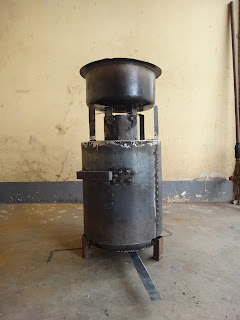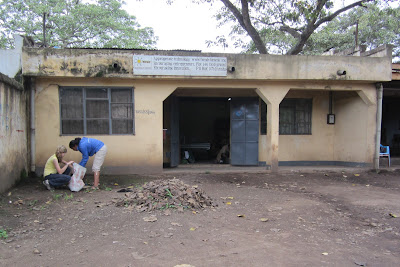On
Saturday, May 26th, we took a short piki piki (motorcycle) ride from
Kalinzi to Matiazo. This village five miles from Kalinzi has a population of
15,000 people. First, we visited an orphanage to get feedback on the coffee
husk stove left there by last summer’s trip.
Afterwards we visited a coffee mill to learn how the husks are utilized
and obtain estimates on output per day.
When we
arrived at Bethel Children’s Home, we were greeted by one of the technicians,
Anania. Although Anania no longer uses the coffee husk stove given to him by
DHE students, it inspired him to construct his own. Some disadvantages of DHE’s
stove are that it smokes considerably when it is first lit, requires frequent
tending, and continues to smoke when a second batch of fuel is added. Anania
noted that the stove burns very hot and fast, so it can only be used to cook
small fish and eggs. Moreover, the sheet metal used to construct the stove is
not very durable.
Over the
past year, Anania has built four coffee husk stoves which better suit the needs
of the orphanage. The two smaller stoves for household-size pots were built one
year ago, while the other two stoves for very large pots were built three
months ago. All the stoves were built using two millimeter sheet metal from
Kigoma. One piece of sheet metal costs 90,000 TSH and can be used to construct
three large stoves or eight small stoves. Anania introduced us to one of the
other technicians, John, who welds the stove components. Amazingly, these four
stoves meet all of the orphanage's food preparation needs. The orphanage
obtains husks for free from the nearby coffee mill and stores extra husks so
that they may continue to use this fuel source
when coffee is not in season.
In contrast
with the two cannisters of DHE's coffee husk stove design, Anania’s stove has a
single cannister. One hole on top of the cannister serves as a chimney for
cooking food, and the other hole on the side is used for feeding a piece of
wood into the stove to start the fire. To fill the stove with fuel, one stick
is placed in the top hole and another in the side hold and coffee husks are
tightly packed around both sticks. Then both sticks are removed and a stick
with a flame is placed in the side hole to light the husks. The stove burns for
about an hour. Anania has shared his stove design with other villagers in
Matiazo who have begun to use the stove in their own homes.
One
disadvantage of Anania's stove is that it produces a very hot flame at the back
of the stove opposite of the side where the lit stick is added. Consequently, a
hole has formed on the back side of the two smaller stoves and Anania has
welded a second layer of sheet metal to this vulnerable area. The flame
produced by the stove is also too hot for the orphanage’s pots, so they have
had to purchase stronger pots. Additionally, coffee husks spill out the side
hole when the sticks are removed after packing the stove with husks. Lastly, we
noticed that Annania's stove produces a lot of smoke.
Moving
forward, DHE can learn from Anania’s feedback and stove design. The orphanage
has taken great strides to reduce its consumption of firewood and diesel. It
uses a German made coffee husk water heater, solar water heaters, solar panels,
and a small wind turbine. Anania encourages future travelers to continue to
visit the orphanage to exchange knowledge about these technologies.
Next, we
visited Kanyovu Coffee Curing Co-op Joint Enterprise to learn more about the
coffee milling process. Ten large coffee producing groups are part of this
cooperative which spans three villages. Five groups in the cooperative own
machines to process the coffee and five groups help collect the coffee. In the
past, coffee growers in the area would send the whole coffee bean to Moshi for
processing. Now, the different groups have various machines to process the
coffee which boosts the local economy and saves shipping costs. We saw two
machines, one which removes the husk from the bean and one which dries and
sorts the beans. The beans are then sent to Moshi to be roasted, packaged, and
shipped.
The machine
which removes the husk from the bean can process 14 tons of coffee per day
and produces a considerable amount of
coffee husk waste. These large coffee husks are collected in a pit. The machine
which dries and sorts the beans removes a finer coffee husk. The husks are
given away to farmers for use as fertilizer and to coffee husk stove users,
such as the orphanage. Although workers at the mill could not give specific
numbers on the amout of husk produced per day, they suggested that there is plenty
of free and available husk to fuel coffee husk stoves in each household
throughout Matiazo.
After we
finished our tour of the coffee mill, the manager showed us a few bags of the
final product. The beans from Kanyovu are roasted by Green Mountain Coffee
Roasters of Vermont which supports conservation programs at the Jane Goodall
Institute. We found it particularly exciting to see DHE's major sponsor and NGO
partner on the roasted bag of coffee!















































.jpg)
.jpg)
.jpg)
.jpg)